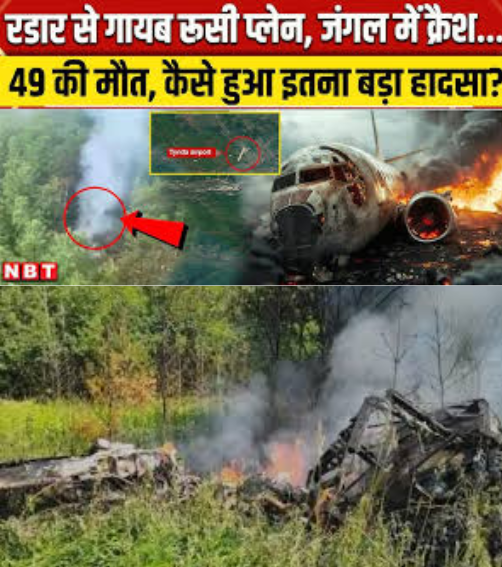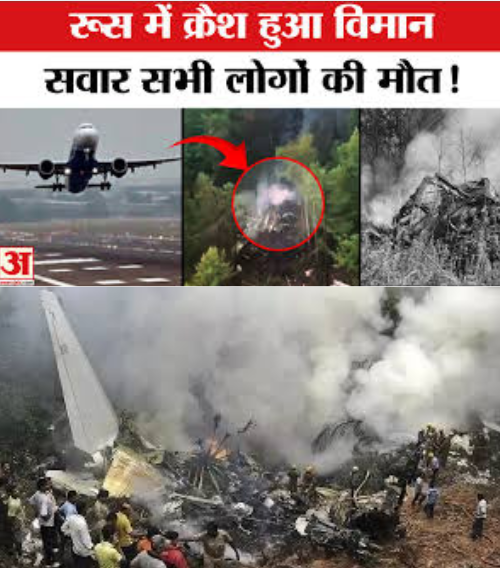Russia Plane Crash: AN 24 crashes in Russia, PM Modi expressed grief over the death of 49 people
In a heart-wrenching tragedy, a Russian passenger aircraft operated by Angara Airlines has crashed near the Chinese border, resulting in the death of all 49 people onboard. The flight, designated AN-24, had taken off for Tynda but disappeared from radar just minutes before its scheduled landing.
Shortly after air traffic control lost communication with the aircraft, panic and confusion set in. Search operations were immediately launched, and hours later, wreckage was discovered in a remote mountainous region near the Russian-Chinese border. The debris was found burning, confirming the worst fears—there were no survivors.
A Nation in Mourning
The incident has sent shockwaves across Russia and beyond. Indian Prime Minister Narendra Modi expressed deep sorrow over the crash, stating, “Deeply saddened by the loss of lives in the tragic plane crash in Russia. Our heartfelt condolences to the families of the victims. In this difficult hour, India stands with the people of Russia.”
The crash occurred in one of Russia’s far-eastern, remote areas—an extremely challenging zone for aviation due to harsh weather, mountainous terrain, and dense forests. Visibility is often poor, and weather conditions can shift rapidly, making flying especially dangerous.
What Caused the Crash?
Initial investigations by Russian news agency TASS suggest that a combination of poor visibility and pilot error during landing may have led to the crash. According to early reports, the crew struggled to land in the deteriorating weather, and a misjudgment during descent likely led to the fatal outcome.
This is not the first time a tragedy like this has unfolded. Aviation accidents—though rare—often result in massive loss of life. In this case, it’s not just a plane that has been destroyed, but also 49 individual worlds: parents, children, spouses—all gone in a matter of moments.

Rescue Operations in Hostile Terrain
As soon as the aircraft went off the radar, local authorities and aviation bodies sprang into action. Rescue teams were dispatched to rugged mountainous areas and forests near the crash site. These regions, covered in thick snow and dense greenery, are known for their difficult accessibility. The rescue effort faced tremendous obstacles due to the treacherous geography and freezing temperatures.
Authorities suspect that the crash might have occurred during an emergency landing attempt, which went catastrophically wrong. The aircraft had reportedly lost altitude rapidly before crashing into hilly terrain and catching fire.
The Fear Around Air Travel Grows
In recent months, a series of aviation incidents globally has sparked growing anxiety among travelers. This latest crash in Russia further contributes to the fear surrounding air travel. Despite statistics showing that flying remains one of the safest modes of transportation, crashes like these create emotional scars that linger for years.
Each time an aircraft lifts off the ground, loved ones hold their breath hoping for a safe return. Sadly, in this instance, that hope has turned into collective grief.

Looking Ahead: Questions That Must Be Answered
While rescue and recovery operations continue, the larger question remains: Could this tragedy have been avoided? Was the aircraft technically sound? Was the crew sufficiently trained to handle such conditions? What role did weather forecasting and ATC play in decision-making?
Russian aviation authorities have promised a full investigation and are expected to release a preliminary report soon. Meanwhile, the country mourns the loss of innocent lives.
As the world reacts to this horrific news, tributes and condolences are pouring in from global leaders and the aviation community.
Play video :
News
Karisma Kapoor’s Ex-Husband Sunjay Kapur’s Mother Makes SHOCKING Claims
Karisma Kapoor’s Ex-Husband Sunjay Kapur’s Mother Makes SHOCKING Claims In a shocking development surrounding the death of Sanjay Kapoor, the…
Saiyaara Actor Ahaan Panday Denied His Relationship With Chunky Panday And Sister Ananya Panday
Saiyaara Actor Ahaan Panday Denied His Relationship With Chunky Panday And Sister Ananya Panday The Bollywood industry is no stranger…
What A Shame! Rubina Dilaik 19-Month-Old Twin Daughters Face Racism
What A Shame! Rubina Dilaik 19-Month-Old Twin Daughters Face Racism In a world increasingly driven by digital appearances and societal…
Payal Malik Made To Sweep and Mop The Temple Premises After Washing Utensils Over Kali Maa Row
Payal Malik Made To Sweep and Mop The Temple Premises After Washing Utensils Over Kali Maa Row Payal Malik, wife…
Oh God, please save Tanushree Dutta! Tanushree Dutta Asking Help Cries Inconsolably In Shocking V…
Oh God, please save Tanushree Dutta! Tanushree Dutta Asking Help Cries Inconsolably In Shocking V… In a world where celebrities…
Because of Bharti Singh, maid Manisha got punishment for her deeds, a big accident happened, Bharti Singh broke down
Because of Bharti Singh, maid Manisha got punishment for her deeds, a big accident happened, Bharti Singh broke down Hello…
End of content
No more pages to load












